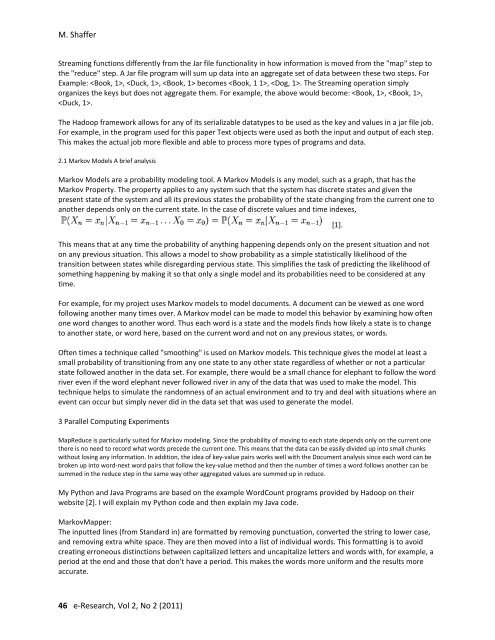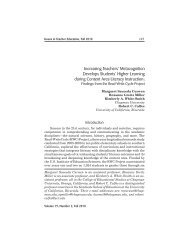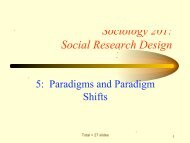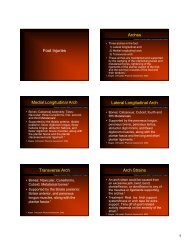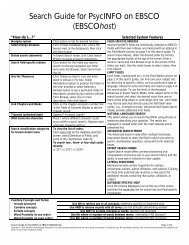e-Research: A Journal of Undergraduate Work - Chapman University
e-Research: A Journal of Undergraduate Work - Chapman University
e-Research: A Journal of Undergraduate Work - Chapman University
Create successful ePaper yourself
Turn your PDF publications into a flip-book with our unique Google optimized e-Paper software.
M. Shaffer<br />
Streaming functions differently from the Jar file functionality in how information is moved from the "map" step to<br />
the "reduce" step. A Jar file program will sum up data into an aggregate set <strong>of</strong> data between these two steps. For<br />
Example: , , becomes , . The Streaming operation simply<br />
organizes the keys but does not aggregate them. For example, the above would become: , ,<br />
.<br />
The Hadoop framework allows for any <strong>of</strong> its serializable datatypes to be used as the key and values in a jar file job.<br />
For example, in the program used for this paper Text objects were used as both the input and output <strong>of</strong> each step.<br />
This makes the actual job more flexible and able to process more types <strong>of</strong> programs and data.<br />
2.1 Markov Models A brief analysis<br />
Markov Models are a probability modeling tool. A Markov Models is any model, such as a graph, that has the<br />
Markov Property. The property applies to any system such that the system has discrete states and given the<br />
present state <strong>of</strong> the system and all its previous states the probability <strong>of</strong> the state changing from the current one to<br />
another depends only on the current state. In the case <strong>of</strong> discrete values and time indexes,<br />
This means that at any time the probability <strong>of</strong> anything happening depends only on the present situation and not<br />
on any previous situation. This allows a model to show probability as a simple statistically likelihood <strong>of</strong> the<br />
transition between states while disregarding pervious state. This simplifies the task <strong>of</strong> predicting the likelihood <strong>of</strong><br />
something happening by making it so that only a single model and its probabilities need to be considered at any<br />
time.<br />
For example, for my project uses Markov models to model documents. A document can be viewed as one word<br />
following another many times over. A Markov model can be made to model this behavior by examining how <strong>of</strong>ten<br />
one word changes to another word. Thus each word is a state and the models finds how likely a state is to change<br />
to another state, or word here, based on the current word and not on any previous states, or words.<br />
Often times a technique called "smoothing" is used on Markov models. This technique gives the model at least a<br />
small probability <strong>of</strong> transitioning from any one state to any other state regardless <strong>of</strong> whether or not a particular<br />
state followed another in the data set. For example, there would be a small chance for elephant to follow the word<br />
river even if the word elephant never followed river in any <strong>of</strong> the data that was used to make the model. This<br />
technique helps to simulate the randomness <strong>of</strong> an actual environment and to try and deal with situations where an<br />
event can occur but simply never did in the data set that was used to generate the model.<br />
3 Parallel Computing Experiments<br />
MapReduce is particularly suited for Markov modeling. Since the probability <strong>of</strong> moving to each state depends only on the current one<br />
there is no need to record what words precede the current one. This means that the data can be easily divided up into small chunks<br />
without losing any information. In addition, the idea <strong>of</strong> key-value pairs works well with the Document analysis since each word can be<br />
broken up into word-next word pairs that follow the key-value method and then the number <strong>of</strong> times a word follows another can be<br />
summed in the reduce step in the same way other aggregated values are summed up in reduce.<br />
My Python and Java Programs are based on the example WordCount programs provided by Hadoop on their<br />
website [2]. I will explain my Python code and then explain my Java code.<br />
MarkovMapper:<br />
The inputted lines (from Standard in) are formatted by removing punctuation, converted the string to lower case,<br />
and removing extra white space. They are then moved into a list <strong>of</strong> individual words. This formatting is to avoid<br />
creating erroneous distinctions between capitalized letters and uncapitalize letters and words with, for example, a<br />
period at the end and those that don't have a period. This makes the words more uniform and the results more<br />
accurate.<br />
46 e-<strong>Research</strong>, Vol 2, No 2 (2011)<br />
[1].


